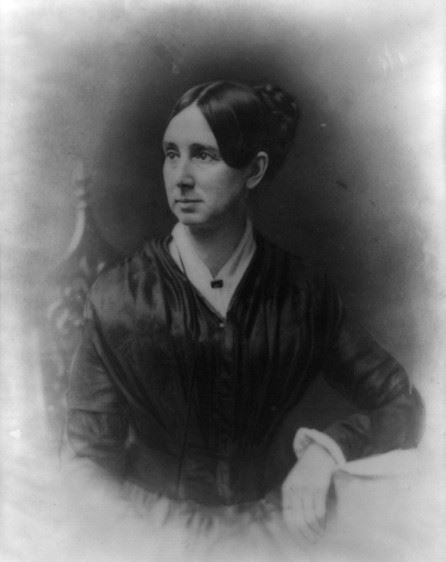by Sarah Halter
 “I come to present the strong claims of suffering humanity. I come to place before the Legislature of Massachusetts the condition of the miserable, the desolate, the outcast. I come as the advocate of helpless, forgotten, insane men and women; of beings sunk to a condition from which the unconcerned world would start with real horror.”
“I come to present the strong claims of suffering humanity. I come to place before the Legislature of Massachusetts the condition of the miserable, the desolate, the outcast. I come as the advocate of helpless, forgotten, insane men and women; of beings sunk to a condition from which the unconcerned world would start with real horror.”
~Dorothea Dix, 1843
A lot of people remember Dorothea Dix for her work during the Civil War as the Superintendent of Army Nurses for the Union Army. She set very high standards for nurses, Her work increased the role of nursing during the war and gave the field of nursing a much-deserved boost by pressing for formal training and more respect for nurses.
But before the War, her activism focused on asylum reform and improving the care and treatment of the mentally ill in the United States. This interest began while she was teaching classes to female prisoners in East Cambridge, Massachusetts. She noticed that many of the individuals incarcerated there had medical needs that weren't being addressed, and she noticed that many of the inmates there were not criminals at all. Many were just paupers. In the basement there, she found four people suffering from severe mental illnesses whose cells were "dark and bare and the air was stagnant and foul.” The poor and the mentally ill who had committed no crime, or whose crimes were directly related to their poverty or mental illness, were locked up along-side violent criminals and treated in the same inhumane way
Beginning in the 1840s, Dix traveled to many states including Indiana, visiting the places where people with mental illnesses were housed and treated- jails as well as mental hospitals- and lobbying State governments for better facilities to care for these “helpless, forgotten” people.
During the 1844-45 Indiana legislative session, on January 13, 1845 to be precise, an "Act to provide for the procuring a suitable site for the erection of a State Lunatic Asylum" was passed and approved. A small committee of physicians that included John Evans, Livingston Dunlap, and James Blake was appointed to choose a site for the new hospital and collect information from around the country about the best plans, specifications, and methods for locating and managing the hospital. Dr. Evans traveled to Ohio, Pennsylvania, and other states to visit similar hospitals and to learn about their design and operations. (Though his legacy is tainted*, his work was instrumental in establishing the Indiana Hospital for the Insane, and he served as the hospital’s first Superintendent.)
In August of 1845, the group settled on 160 acres of farmland west of Indianapolis along the National Road as the site for the hospital. It was swampy land. But it was also two miles out of the city, and there weren't many residents in the area to complain about a mental hospital in their back yard. It had a high point that would command a pretty nice view of the surrounding area. Generally, the committee thought it would be well-suited for the hospital, and it was affordable at $13 and 12 1/2 cents per acre. The State acquired the property right away. In January of 1846, another act of legislation provided funding for construction of the buildings themselves, and work began on the main building: a three-story building with an additional basement and attic.
The first five patients were admitted to the hospital on November 21, 1848, though the building took several more years to truly finish and new wards were still being added to the wings of the building until the early 1870s as the hospital population grew.
Throughout the hospital’s history, it was plagued by many challenges including insufficient funds, corruption, and justified allegations of abuse and neglect. But there was another side of the hospital that is important to remember, too. It offered hope and healing to thousands of Hoosiers who previously would have ended up in the poor houses and jails that Dix and others condemned. Indiana had taken Dorothea Dix’ words to heart.
(photo: Dorothea Dix, retouched, undated photograph, Library of Congress) 
*In mentioning John Evans and his work in Indiana, it is important to also acknowledge his role in the Sand Creek Massacre. In 1864 as Governor of Colorado Territory, John Evans issued a proclamation authorizing the citizens of Colorado to “kill and destroy, as enemies of the country, wherever they may be found…hostile Indians.” Recent research indicates that likely he neither knew about nor helped plan the Sand Creek Massacre that occurred that year, but his policies toward and prior treatment of the Native Americans in his territory, make his culpability in the massacre clear. One hundred and fifty Cheyenne and Arapaho, mostly women and children, were brutally killed, and in the aftermath of the massacre, Evans defended what happened, showing little or no remorse for the suffering and loss that occurred.